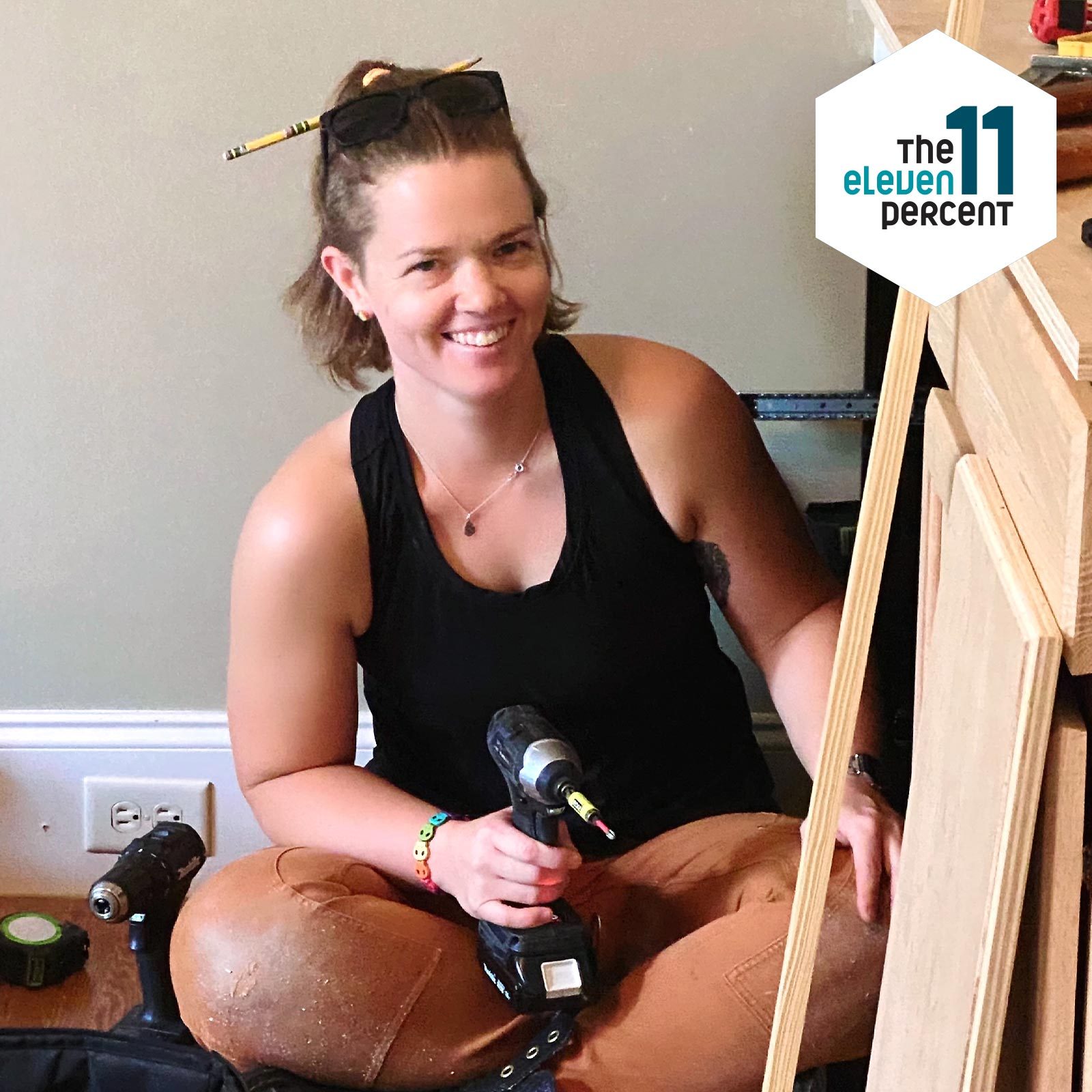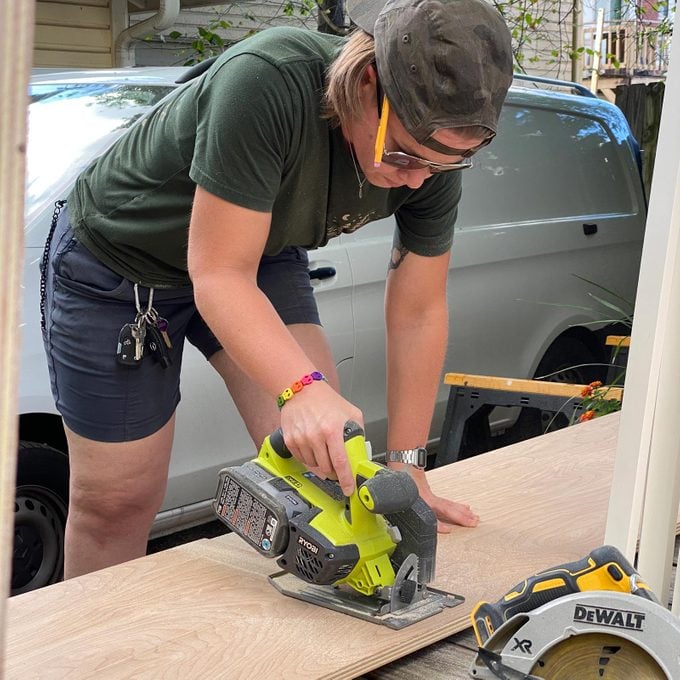Pro Handyperson Kat Christie talks about the joy of breathing new life into old things and how women are changing the DIY game.

The Eleven Percent: Meet Kat Christie, Residential Handyperson

This FH series introduces readers to a few of the women who make up 11 percent of the construction workforce in the U.S., spotlighting stories of their careers in the field. Know someone we should feature? Email us here.
Eight years ago, Kat Christie took her childhood love of tinkering pro, starting as an espresso machine technician. That ignited her curiosity and desire to delve into home repair. In 2017, she earned a Handyman Certificate Course from York College in Queens, New York, a major step toward her dream of running her own handywoman business.
Christie launched She Fixed That in 2019, and went full-time the following year at the start of the pandemic. Since people were home, mulling unfinished projects and ordering home office necessities, her business took off. “Patching a small hole in a wall, furniture assembly, hanging TVs and gallery walls, building pantries and library walls — no day is the same,” Christie says.
In 2021 she moved from New Jersey to Birmingham, Alabama and quickly re-established her business in the new location. “Up north or down south, people want to hire women. Women want to hire women,” she says. “It’s a niche that I think exists everywhere.”
We asked Christie for her thoughts on the state of the residential handyperson business.
On This Page
Q: How did you get into fixing things?
A: I got a philosophy degree, so naturally, here we are, right? Ha! Jokes aside, I’ve always been a tinkerer. As a kid, I stole my brother’s Legos, K’Nex and Lincoln Logs. I took apart the old VCR to see how it worked, and loved building forts with pillows, sticks, boxes — anything really.
Later in life, while working in the coffee industry, our units would occasionally break down, and the company dispatched a tech. I loved when this one tech, Jay, came out. I’d pick his brain, curious about how the machine’s internal components worked. He was patient, knowledgeable and cool as hell. I wanted to be him.
Fast forward some years, and I landed a job as a tech repairing those same coffee machines. That was one of the best jobs I’ve had— a road warrior, fixing things and keeping America caffeinated. I felt like a superhero and still reminisce about it.
The thing of it is, once you know how a boiler, valve, flow meter and switch all work, it’s transferable to everything: cars, washing machines, water heaters and so on.
Q: What are some of your favorite fix-it jobs?
A: My heart is in mechanical and carpentry. Given my prior experience, I especially enjoy small-appliance repair.
I love hunting for a service manual with an exploded-parts diagram tucked away in an internet corner and sifting through troubleshooting forums online to find the fix. In this disposable culture we live in, making something old work again, like rewiring a lamp or dissecting an antique mortise lock, is exceptionally satisfying.
Carpentry is the inverse — I build rather than take apart. But issues always arise. Not as dramatic as HGTV, but something to troubleshoot nonetheless. I love to cope trim. There’s nothing more satisfying than an invisible joint!
My absolute favorite fix-it job isn’t something specific. It’s when a client has had to work around/settle with a seemingly minor issue, be it a stuck drawer, loose knob, door that doesn’t latch right, broken hinge, you name it. When the fix brings ease back into their lives, I’ve done my job.
Q: Tell us about a project that stood out.
A: One carpentry project I’m proud of is a gentleman’s closet in a historic home here in Birmingham. The challenge was to make a fraternal twin of an existing bookcase. I had to match the trim profiles and shape by milling stock lumber and making the case seamless, which meant scribing the trimwork to the wavy plaster walls.
There was trial and error, as well as tears, joy and cuss words, but it turned out beautifully. Now, when the client has friends over, he plays the game “Guess Which One Is Original?” People cannot tell, and that’s the win for me. The project stretched my skills, and I grew as a result.
Q: Who is your main clientele?
A: Mostly women. Moms, single women, divorcees, retirees and LGBTQ folks. As a member of the gay community, my clients feel at ease with me.
Q: How has being a woman helped your business?
A: People hire me because I’m a woman. I’m told I’m more approachable. And women, specifically, aren’t afraid to ask questions, knowing I’ll answer respectfully, without judgement.
And if I don’t know the answer, I’m honest about it, and instead get back with it. This fosters transparency and trust, which I’ll do everything in my power to protect, project and respect. I’ve had first-time clients who’ve left me alone in the house and insisted I make “myself at home.”
I should also note that I’ve not experienced direct discrimination on account of my gender. Sure, I get stared at a lot, and questioned when I walk into the home center in my work clothes. But I often get high-fives or accolades like, “Yeah, girl. You get it.”
Q: What’s your impression of gender diversity in the trades?
A: I’m seeing more women who are interested in the trades acting on that interest. When I was a field technician, female clients were taken aback by me. They’d say, “Oh, my gosh, I didn’t even know that they hired women! I would love to do something like that.” If my company was hiring, I’d direct them to apply.
I also see more female lube techs, field techs, painters, etc. I interact with female DIYers through Instagram, helping them through projects, answering questions and directing them to resources.
Today, there are entire communities on social media for handywomen, female DIYers, tradeswomen, trans-handy people, all of it. I’ve noticed that language has changed, too. People are more mindful of not saying a default “he” when referring to a tradesperson. That’s big.
Q: What changes do you hope are on the horizon?

A: I would love to see more brands recognize that women are a real and serious demographic as it relates to workwear and tools. It’s starting, but it’s not quite there yet. I still shop in the men’s section for workwear, though women’s items from brands like Duluth, Carhartt and Dovetail scatter my closet.
How about Mother’s Day tool deals? And not that generic pink tool set. I’d like to see tool companies consider women in their ergonomics. Women do the research and want the best or right tool for the job. And grip, weight and power are just as important to them.
I want little girls to know that being a tradesperson is a career path they can choose. This starts in children’s books and in marketing departments.
I’d love to get to a point where I can hire a team of women. My big dream is to teach classes and workshops for women and LGBTQ people, to create a safe space to empower, inspire, build knowledge and ask questions.
Q: Any advice for how people can generally make themselves more handy?
A: If in your immediate circle you don’t have a handy friend to lean on, find other people willing to share knowledge. Cue the internet! YouTube is a phenomenal resource, as are sites like the Family Handyman. There are tons of social media accounts and Facebook groups out there, whole communities of people interested in the same things you are.
If you’re a paper person, Black+Decker has a great book, The Complete Photo Guide To Home Repair. It’s a fabulous springboard. For a more contractor-centric in-depth resource, pick up Renovation, by Litchfield and Harley.
Q: What are your pro-specific tools?
A: My favorite screwdriver is my Klein 11-in-1. In a pinch, I’ll even pop the bit in my drill. Then my have a Makita subcompact drill and driver set. They’re durable, powerful, and the weight balance is fabulous. Having small hand grips is important and these feel great.
My Husky 15-in-1 painter’s tool is vital. From prying off trim to opening paint cans and boxes to scouring caulk and scraping stickers, I love it. It even comes with a little flat-head screwdriver piece to remove screws on switch plates.
This little 90-degree ratcheting pocket screwdriver has saved me in tight spots. I use it a ton when assembling furniture with delicate plastic bits, where a drill is too much power, even with the torque adjusted. The ratcheting feature also reduces hand fatigue.
There’s also my Kat paw (see what I did there?), aka pry bar. It’s very versatile and I can get leverage in tight spots. Finally, my nail/staple puller is a godsend. The leverage I can get with this is remarkable, and the head design leaves little damage to the workpiece.
Kat Christie Bio
Kat Christie is the owner of She Fixed That handywoman services, with eight years of experience repairing things for a living.
She started as a field tech repairing coffee equipment and was soon promoted to lead technician, then regional manager. She earned a Handyman Certificate from York College, and still pours over manuals and videos to deepen her knowledge and experience.
While her primary focus is mechanical repair and finish/trim carpentry, Christie genuinely believes no job is too small if it makes a difference in a person’s life. She strives to provide transparent, trustworthy and professional services to her clients and dreams of creating a safe and empowering educational space for women and LGBTQ folks.
Born and raised in the New York metropolitan area, Christie currently lives and works with her partner out of a beautiful historic home in Birmingham, Alabama, which keeps them both busy! She is a dog momma and aspiring knitter, and enjoys the outdoors, cooking and a good dad joke.
Writer Karuna Eberl Bio
Karuna Eberl is a regular contributor to FamilyHandyman.com. She spent the last 25 years as a freelance journalist and filmmaker, telling stories of people, nature, travel, science and history. Eberl has won numerous awards for her writing, her Florida Keys Travel Guide and her documentary The Guerrero Project.




















